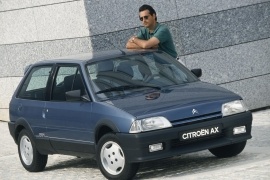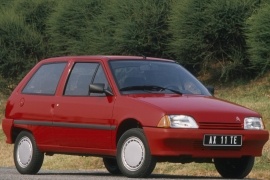CITROEN AX 3 Doors Models/Series Timeline, Specifications & Photos
First production year: 1986
Engines: Gasoline, Diesel
Body style: Hatchback
After five years since it was launched, the small Citroen AX received a facelift in 1991, trying to keep up with the latest design trends, and the receive worked well since it could stay on the market until 1998.
Peugeot managed to save Citroen after imposing some drastic measures. The new owner not only that it reduced the number of platforms used but also ditched the boxer engines. But that was not enough. Thus, it managed to create a small-sized vehicle called AX, which had to stay longer on the market to decrease the manufacturing costs per unit. But that wasn't possible just by using the same initial shape and engine range. Thus, in 1991, after the dismissal of the 2CV range, the AX remained the smallest Citroen on sale, and it had to attract some of its former sibling customers.
The facelifted version of the AX was available in a three- or five-door configuration. On the facelifted version, the car got rounded edges. Yet, the headlights, even though they looked more up-to-date thanks to the clear blinkers, remained angular-shaped. In this version, there were no exterior door handles. They were concealed in the B-pillar. To ensure proper ventilation, Citroen installed pop-out windows for the rear seats.
Inside, the new dashboard featured a smaller instrument cluster, which was also cheaper to produce. Yet the materials' quality was increased, thus creating a better, friendlier environment. At the back, the car provided just enough room for a couple of teenagers.
Under the hood, Citroen installed a wide choice of engines, similar to those on the five-door version. Yet, the three-door received a sportier version of the 1.4-liter powerplant, which offered more power. It was developed to be used on local, mono-brand races.
According to Citroen, the little AX might be considered the first supermini vehicle built by the "double-chevron" carmaker.
At the beginning of '80s, Citroen started to develop a vehicle to replace the aging Axel/Visa lineup. The three-door AX replaced the Axel, while the five-door replaced the Visa. With a new design based on a modified platform from its predecessor, the little French car started its 12 years career in 1986. It was light, agile, and highly fuel-efficient. A naturally aspirated diesel version of the AX earned its place in the Guinness World Book of Record with its 2.7 l/100 km (87.1 mpg-US) fuel consumption.
Despite its boxy look, the AX featured a stunning-low drag coefficient of just 0.31. Its headlights reflected the car's shape, and the turn-signals were mounted on the corners, so the carmaker didn't have to install an additional set on the sides. A special Rallye (or AX Sport) version was fitted with white steel wheels, which evoked the same design as for the successful Peugeot 205.
The interior design followed the same wedged shapes from the outside, with a dashboard that looked like it was made from vinyl-covered plywood. Apart from the steering wheel, everything else inside was made in straight lines and straight angles. To save weight, the car lacked sound-deadening materials and exposed metal parts here and there.
Citroen fitted the little AX 3-doors with a wide choice of engines ranged between 42 hp and 96 hp. The 1.4-liter diesel version was famous for its fuel efficiency and for its noisy running, but it was reliable and could run over 1000 miles (1609 km) on a tank.

